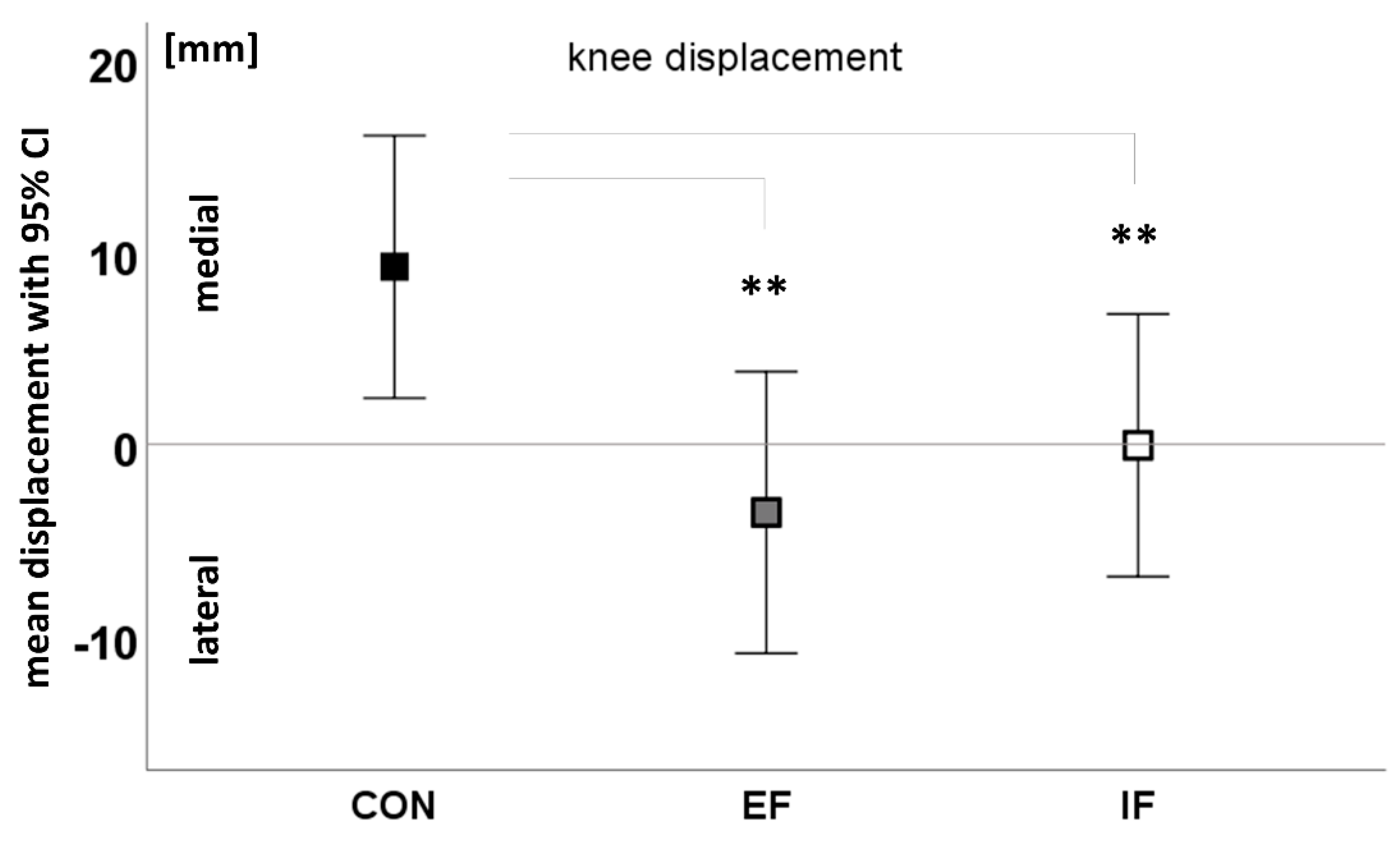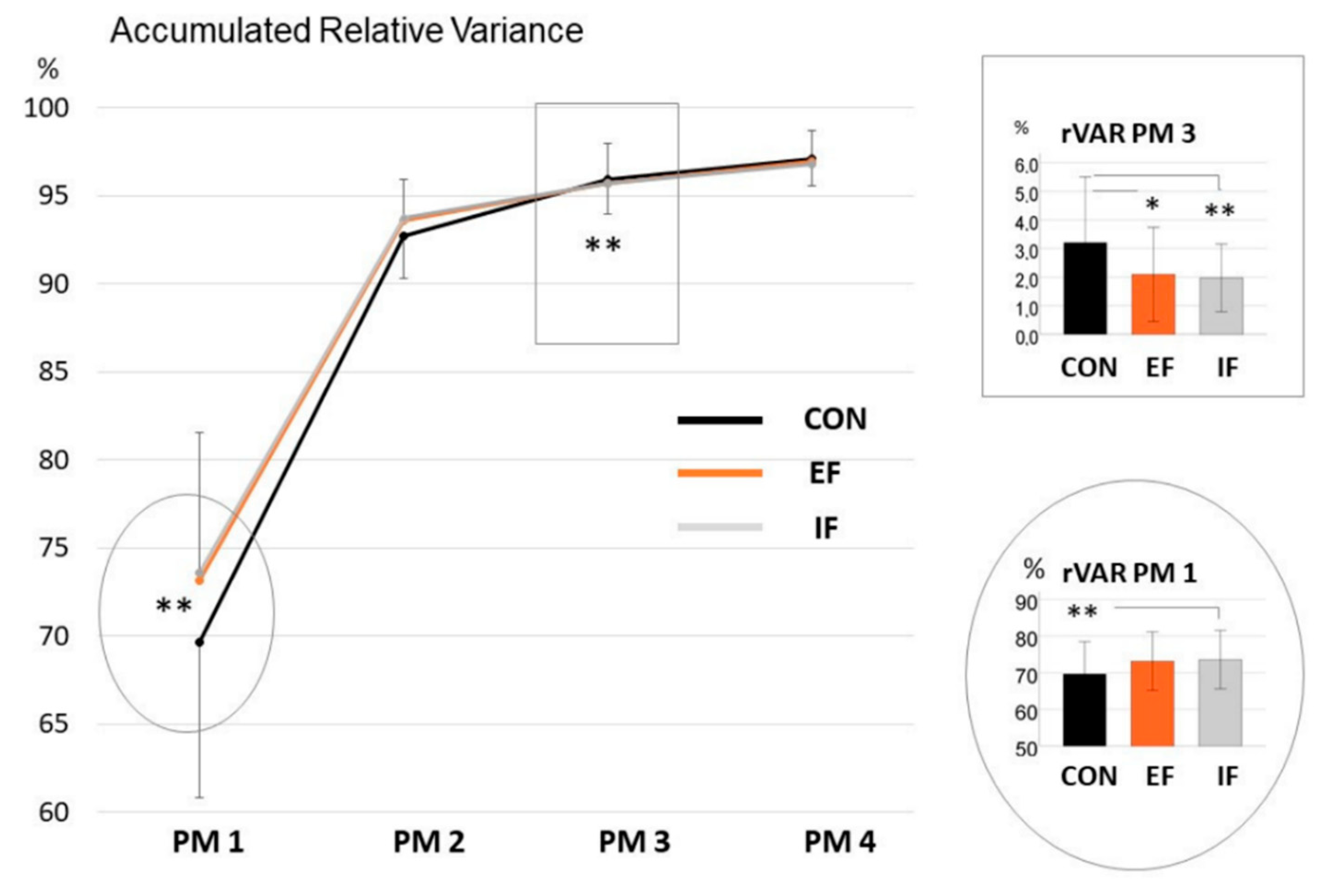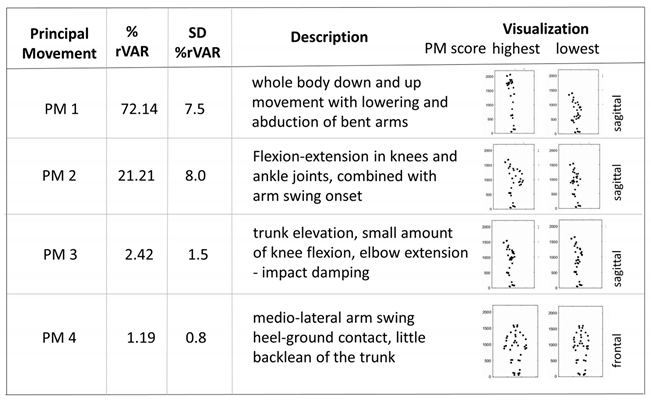Intervention for Better Knee Alignment during Jump Landing: Is There an Effect of Internally vs. Externally Focused Instructions?
Abstract
:1. Introduction
2. Materials and Methods
2.1. Participants
2.2. Experimental Design
2.3. Data Collection and Data Analysis
2.4. Statistical Analysis
3. Results
3.1. Knee Alignment
3.2. Principal Components
4. Discussion
5. Conclusions
Author Contributions
Funding
Institutional Review Board Statement
Informed Consent Statement
Data Availability Statement
Conflicts of Interest
References
- Wulf, G.; McNevin, N.; Shea, C. The automaticity of complex motor skill learning as a function of attentional focus. Q. J. Exp. Psychol. 2001, 54, 1143–1154. [Google Scholar] [CrossRef] [PubMed]
- Wulf, G. Attentional focus and motor learning: A review of 15 years. Int. Rev. Sport Exerc. Psychol. 2013, 6, 77–104. [Google Scholar] [CrossRef]
- Chiviacowsky, S.; Wulf, G.; Wally, R. An external focus of attention enhances balance learning in older adults. Gait Posture 2010, 32, 572–575. [Google Scholar] [CrossRef] [PubMed]
- Wu, W.; Porter, J.; Brown, L. Effect of Attentional Focus Strategies on Peak Force and Performance in the Standing Long Jump. J. Strength Cond. Res. 2012, 26, 1226–1231. [Google Scholar] [CrossRef]
- Kershner, A.; Fry, A.; Cabarkapa, D. Effect of Internal vs. External Focus of Attention Instructions on Countermovement Jump Variables in NCAA Division I Student-Athletes. J. Strength Cond. Res. 2019, 33, 1467–1473. [Google Scholar] [CrossRef]
- McKay, B.; Wulf, G. A distal external focus enhances novice dart throwing performance. Int. J. Sport Exerc. Psychol. 2012, 10, 149–156. [Google Scholar] [CrossRef]
- Perkins-Ceccato, N.; Passmore, S.; Lee, T. Effects of focus of attention depend on golfer’s skill. J. Sports Sci. 2003, 21, 593–600. [Google Scholar] [CrossRef]
- Shafizadeh, M.; McMorri, T.; Sproule, J. Effect of Different External Attention of Focus Instruction on Learning of Golf Putting Skill. Percept. Mot. Ski. 2013, 113, 662–670. [Google Scholar] [CrossRef]
- Lawrence, G.; Virian, J.; Oliver, S.; Gottwald, V. Lets got surfing now, everybody’s learning how; attentional strategies on expert and novice surfing performance under both practice and competition conditions. Eur. J. Sport Sci. 2019, 20, 229–239. [Google Scholar] [CrossRef]
- Hossner, E.; Wenderoth, N. Gabriele Wulf on Attentional Focus and Motor Learning. E-J. Beweg. Train. 2007, 1, 1–64. [Google Scholar]
- Kakebeeke, T.; Knols, R.; de Bruin, E. Should Rehabilitation Specialists Use External Focus Instructions When Motor Learning is Fostered? A Systematic Review. Sports 2013, 1, 37–57. [Google Scholar] [CrossRef] [Green Version]
- Collins, D.; Carson, H.; Toner, J. Letter to the editor concerning the article “Performance of gymnastics skill benefits from an external focus of attention” by Abdollahipour, Wulf, Psotta & Nieto (2015). J. Sports Sci. 2016, 34, 1288–1292. [Google Scholar] [CrossRef] [PubMed]
- Lawrence, G.; Gottwald, V.; Hardy, J.; Khan, M. Internal and External Focus of Attention in a Novice Form Sport. Res. Q. Exerc. Sport 2011, 82, 431–441. [Google Scholar] [CrossRef] [PubMed]
- Abdollahipour, R.; Wulf, G.; Psotta, R.; Palomo Nieto, M. Performance of gymnastics skill benefits from an external focus of attention. J. Sports Sci. 2015, 33, 1807–1813. [Google Scholar] [CrossRef]
- Zentgraf, K.; Munzert, J. Effect of attentional-focus instructions on movement kinematics. Psychol. Sport Exerc. 2009, 10, 520–525. [Google Scholar] [CrossRef]
- Lohse, K.; Jones, M.; Healy, A.; Sherwood, D. The Role of Attention in Motor Control. J. Exp. Psychol. 2014, 143, 930–948. [Google Scholar] [CrossRef]
- Schutts, K.; Wu, W.; Vidal, A.; Hiegel, J.; Becker, J. Does Focus of Attention Improve Snatch Lift Kinematics? J. Strength Cond. Res. 2016, 31, 2758–2764. [Google Scholar] [CrossRef]
- Irmischer, B.; Harris, C.; Pfeifer, R.; DeBeliso, M.; Adams, K.; Shea, K. Effects of a Knee Ligament Injury Prevention Exercise Program on Impact Forces in Women. J. Strength Cond. Res. 2004, 18, 703–707. [Google Scholar]
- Otsuki, R.; Kuramochi, R.; Fakubayashi, T. Effect of injury prevention training on knee mechanics in female adolescents during puberty. Int. J. Sports Phys. Ther. 2014, 9, 149–156. [Google Scholar] [CrossRef]
- Gokeler, A.; Neuhaus, D.; Benjaminse, A.; Grooms, D.; Baumeister, J. Principles of Motor Learning to Support Neuroplasticity After ACL Injury: Implications for Optimizing Performance and Reducing Risk of Second ACL Injury. Sports Med. 2019, 49, 853–865. [Google Scholar] [CrossRef]
- Welling, W.; Benjaminse, A.; Gokeler, A.; Otten, B. Enhanced retention of drop vertical jump landing technique: A randomized controlled trial. Hum. Mov. Sci. 2016, 45, 84–95. [Google Scholar] [CrossRef] [PubMed]
- Benjaminse, A.; Welling, W.; Otten, B.; Gokeler, A. Transfer of improved movement technique after receiving verbal external focus and video instruction. Knee Surg. Sports Traumatol. Arthrosc. 2018, 26, 955–962. [Google Scholar] [CrossRef] [PubMed] [Green Version]
- Van Ginneken, W.; Poolton, J.; Capio, C.; van der Kamp, J.; Choi, C.; Masters, R. Conscious Control is Associated With Freezing of Mechanical Degrees of Freedom During Motor Learning. J. Mot. Behav. 2018, 50, 436–456. [Google Scholar] [CrossRef] [PubMed]
- Verrel, J.; Lövdén, M.; Schellenbach, M.; Schäfer, S.; Lindenberger, U. Interacting Effects of Cognitive Load and Adult Age on the Regularity of Whole-Body Motion During Treadmill Walking. Psychol. Aging 2009, 24, 75–81. [Google Scholar] [CrossRef]
- Daffertshofer, A.; Lamoth, C.; Meijer, O.; Beek, P. PCA in studying coordination and variability: A tutorial. Clin. Biomech. 2004, 19, 415–428. [Google Scholar] [CrossRef]
- Federolf, P. A novel approach to study human posture control: “Principal movements” obtained from a principal component analysis of kinematic marker data. J. Biomech. 2016, 49, 364–370. [Google Scholar] [CrossRef]
- Promsri, A.; Haid, T.; Federolf, P. Complexity, Composition, and Control of Bipedal Balancing Movements as the Postural Control System Adapts to Unstable Support Surfaces or Altered Feet Positions. Neuroscience 2020, 430, 113–124. [Google Scholar] [CrossRef]
- Nordin, A.; Dufek, J. Neuromechanical synergies in single-leg landing reveal changes in movement control. Hum. Mov. Sci. 2016, 49, 66–78. [Google Scholar] [CrossRef]
- Haid, T.; Federolf, P. Human Postural Control: Assessment of Two Alternative Interpretations of Center of Pressure Sample Entropy through a Principal Component Factorization of Whole-Body Kinematics. Entropy 2018, 20, 30. [Google Scholar] [CrossRef]
- Keller, M.; Kuhn, Y.; Lüthy, F.; Taube, W. How to Serve Faster in Tennis: The Influence of an Altered Focus of Attention and Augmented Feedback on Service Speed in Elite Players. J. Strength Cond. Res. 2021, 35, 1119–1126. [Google Scholar] [CrossRef]
- Maurer, H.; Munzert, J. Influence of attentional focus on skilled motor performance: Performance decrement under unfamiliar focus conditions. Hum. Mov. Sci. 2013, 32, 730–740. [Google Scholar] [CrossRef] [PubMed]
- Davis, R.; Ounpuu, S.; Tyburski, D.; Gage, J. A gait analysis collection and reduction technique. Hum. Mov. Sci. 1991, 10, 575–587. [Google Scholar] [CrossRef]
- Federolf, P. A novel approach to solve the “missing marker problem” in marker-based motion analysis that exploits the segment coordination patterns in multi-limb motion data. PLoS ONE 2013, 8, e78689. [Google Scholar] [CrossRef]
- Gløersen, Ø.; Federolf, P. Predicting Missing Marker Trajectories in Human Motion Data Using Marker Intercorrelations. PLoS ONE 2016, 11, e0152616. [Google Scholar] [CrossRef] [PubMed]
- Haid, T.; Zago, M.; Promsri, A.; Doix, C.; Federolf, P. PManalyzer: A Software Facilitating the Study of Sensorimotor Control of Whole-Body Movements. Front. Neuroinform. 2019, 113, 24. [Google Scholar] [CrossRef] [PubMed]
- Winkelman, N.; Clark, K.; Ryan, L. Experience level influences the effect of attentional focus on sprint performance. Hum. Mov. Sci. 2017, 52, 84–95. [Google Scholar] [CrossRef] [PubMed]
- Kristiansen, M.; Samani, A.; Vuillerme, N.; Madeleine, P.; Hansen, E. External and Internal Focus of Attention Increases Muscular Activation During Bench Press in Resistance-Trained Participants. J. Strength Cond. Res. 2018, 32, 2442–2451. [Google Scholar] [CrossRef] [PubMed]
- Nazdalan, A.; Lee, J.; Mohamed, N.; Azzfar, M.; Malek, N.; Waqqash, E. The Effects of Focus Attention Instructions on Movement Kinetics, Muscle Activation and Performance during Resistance Exercise. J. Phys. Conf. Ser. 2020, 1529, 022008. [Google Scholar] [CrossRef]
- Hossner, E.; Ehrlenspiel, F. Time-referenced effects of an internal vs. external focus of attention on muscular activity and compensatory variability. Front. Psychol. 2010, 1, 230. [Google Scholar] [CrossRef]
- Vidal, A.; Wu , W.; Nakajama , M.; Becker, J. Investigationg the Constraint Action Hypothesis: A Movement Coordination and Coordination Variability Approach. J. Mot. Behav. 2018, 50, 528–537. [Google Scholar] [CrossRef]
- Haines, M.; Murray, A.; Glaviano, N.; Gokeler, A.; Norte, G. Restricting ankle dorsifexion does not mitigate the benefits of external focus of attention on landing biomechanics in healthy females. Hum. Mov. Sci. 2020, 74, 102719. [Google Scholar] [CrossRef] [PubMed]
- Bernstein, N. The Coordination and Regulation of Movements; Pergamon: London, UK, 1967. [Google Scholar]
- Gray, R. Changes in Movement Coordination Associated With Skill Acquisition in Baseball Batting: Freezing/Freeing Degrees of Freedom and Functional Variability. Front. Psychol. 2020, 11, 1295. [Google Scholar] [CrossRef] [PubMed]
- Fietzer, A.; Winstein, C.; Kulig, C. Changing one’s focus of attention alters the structure of movement variability. Hum. Mov. Sci. 2018, 62, 14–24. [Google Scholar] [CrossRef] [PubMed]
- Cocks, A.; Young, W.; Ellmers, T.; Jackson, R.; Williams, M. Concern about falling is associated with segmental control when turning in older adults. Gait Posture 2021, 88, 105–108. [Google Scholar] [CrossRef]


 |
Publisher’s Note: MDPI stays neutral with regard to jurisdictional claims in published maps and institutional affiliations. |
© 2022 by the authors. Licensee MDPI, Basel, Switzerland. This article is an open access article distributed under the terms and conditions of the Creative Commons Attribution (CC BY) license (https://creativecommons.org/licenses/by/4.0/).
Share and Cite
Werner, I.; Peer-Kratzer, M.; Mohr, M.; van-Andel, S.; Federolf, P. Intervention for Better Knee Alignment during Jump Landing: Is There an Effect of Internally vs. Externally Focused Instructions? Int. J. Environ. Res. Public Health 2022, 19, 10763. https://doi.org/10.3390/ijerph191710763
Werner I, Peer-Kratzer M, Mohr M, van-Andel S, Federolf P. Intervention for Better Knee Alignment during Jump Landing: Is There an Effect of Internally vs. Externally Focused Instructions? International Journal of Environmental Research and Public Health. 2022; 19(17):10763. https://doi.org/10.3390/ijerph191710763
Chicago/Turabian StyleWerner, Inge, Monika Peer-Kratzer, Maurice Mohr, Steven van-Andel, and Peter Federolf. 2022. "Intervention for Better Knee Alignment during Jump Landing: Is There an Effect of Internally vs. Externally Focused Instructions?" International Journal of Environmental Research and Public Health 19, no. 17: 10763. https://doi.org/10.3390/ijerph191710763
APA StyleWerner, I., Peer-Kratzer, M., Mohr, M., van-Andel, S., & Federolf, P. (2022). Intervention for Better Knee Alignment during Jump Landing: Is There an Effect of Internally vs. Externally Focused Instructions? International Journal of Environmental Research and Public Health, 19(17), 10763. https://doi.org/10.3390/ijerph191710763








